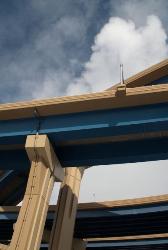Dec 23 2009
The Rutgers Center for Advanced Infrastructure and Transportation (CAIT) has been awarded U.S. Commerce Department funding toward a $17.9 million project aimed at improving bridge maintenance and safety.
 The Rutgers Center for Advanced Infrastructure and Transportation has been awarded US Commerce Department funding toward a $17.9 million project aimed at improving bridge maintenance and safety
The Rutgers Center for Advanced Infrastructure and Transportation has been awarded US Commerce Department funding toward a $17.9 million project aimed at improving bridge maintenance and safety
Funding from the Commerce Department's National Institute of Standards and Technology (NIST) will cover $8.8 million of the project. The agency made the award through its Technology Innovation Program, which provides cost-shared funding for innovative, high-risk research in technologies that address critical national needs.
Between 50 and 85 percent of bridge maintenance costs go toward repair or replacement of bridge decks – the surfaces vehicles travel on. The technologies that CAIT is developing will help highway crews detect flaws in bridge decks at an early stage, often before they would show up in traditional inspections. They also will address ways to quickly and economically repair flaws, such as small cracks, while they are still minor, reducing later need for expensive bridge deck rehabilitation or replacement.
The technologies also will give highway crews an idea of how bridge deck deterioration is affecting the performance of other bridge components, such as beams and supports. This will help highway authorities take steps to extend bridge life and maintain safety.
"By-and-large, crews today inspect bridge decks visually and manually – looking for visible cracks or by dragging chains across pavement while listening for sounds that indicate hidden flaws," said Nenad Gucunski, director of the Infrastructure Condition Monitoring Program at Rutgers' CAIT. "While moderately effective when done by experienced crews, these techniques are slow and they rely on human interpretation and judgment."
Gucunski, also professor of civil and environmental engineering in the Rutgers School of Engineering, said the project's objective is to develop tools that help crews inspect bridge decks quickly and thoroughly, evaluate results accurately and consistently, and perform simple repairs that minimize later need for expensive and disruptive rehabilitation.
The project, formally known as the Automated Nondescructive Evaluation and Rehabilitation System (ANDERS) for Bridge Decks, involves partners from Drexel University and Pennoni Associates Inc. in Philadelphia; Mala GeoScience USA, Inc. in Charleston, S.C.; and PD-LD, Inc. in Pennington, N.J.
The ANDERS condition evaluation component will use ground-penetrating radar and seismic and ultrasonic systems to identify and characterize localized deterioration. Another component will analyze how the bridge structure responds to applied impacts and shed light on how localized deterioration affects the bridge's overall performance. ANDERS will analyze data from both components to simulate extent of bridge deck deterioration and its effect on the bridge's capacity and structural vulnerability.
The ANDERS project also will develop materials and robotic equipment able to repair the internal structure of a bridge deck, from hairline crevasses to large delaminations – cracks in the concrete that develop when corroding steel expands.
This year's competition in the NIST Technology Innovation Program addressed advanced materials and public infrastructure systems. NIST is a nonregulatory agency of the U.S. Department of Commerce that promotes innovation and industrial competitiveness by advancing measurement science, standards and technology in ways that enhance economic security and improve quality of life.
Source: http://www.rutgers.edu/